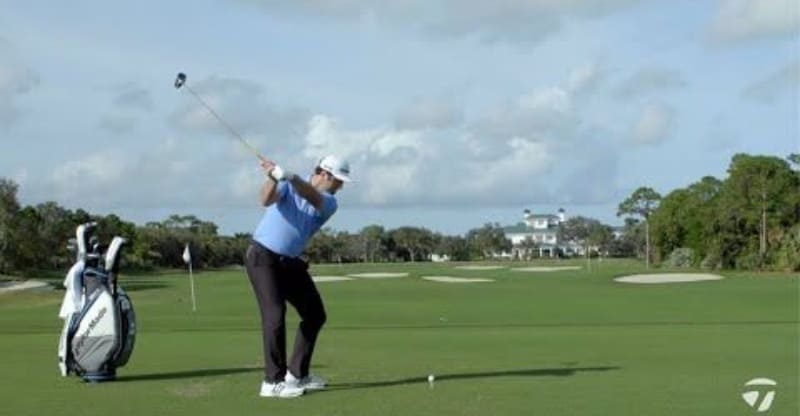How To Hit a Fade in Golf? The Differences and Tips
In golf, the way you hit the ball matters a lot. It’s not just about getting the ball into the target hole. It’s about doing so with skill and using fewer strokes. This is why mastering different shot types is essential.
One of the trickiest shots to get the hang of is a fade. It’s a controlled type of shot that adds a touch of proficiency to your game. So, what is a fade in golf? And how do you hit one? That’s what I’m here today to talk about.
In this article, you’ll find out everything about the fade shot and when to use it in your game. You’ll also get to know how it differs from other shots and what tips you need to learn to master a fade. Continue scrolling to discover more.
What Is a Fade in Golf?
In golf, a fade is a technique of hitting the ball that forces it to gently curve while traveling through the air. Instead of going straight, the ball starts a bit to the left and then bends to the right as it begins to land.
Such directions are the default for right-handed players. As for left-handed golfers, it’s the other way around. This means that if you’re left-handed, the ball will start a bit to the right and then curve to the left.
Overall, you can say that a fade is the mirror version of the draw shot that curves in the opposite direction.

Image source: Pinterest
Why Is Mastering a Fade Important?
The fade, as well as many other shots, are crucial skills for golfers to acquire. It holds strategic advantages in many situations.
Here are a few reasons why mastering a fade is essential.
- It allows you to adjust to the different course conditions and navigate around obstacles, such as trees, bodies of water, or bunkers.
- It gives you the ability to position yourself better for your next shot.
- It’s an excellent shot, especially for holes that dogleg to the right.
- It gives you greater control over the ball.
- It helps you reduce the impact of crosswinds (especially left-to-right winds) and keep your shot on target.
What Is the Difference Between a Fade and a Slice?
If you’re familiar with the slice shot, you may find it similar to the fade. Like a fade, a slice also starts to the left and curves to the right as it flies towards its target. So, what makes a fade different?
Principally, a fade is a more controlled and reliable version of the slice. While its line of movement is almost the same, a fade doesn’t cover as much distance in the sideways direction as a slice.
This means a fade typically has a shallower curve and stays closer to the intended target line. Therefore, it’s easier to predict and control. In contrast, a slice usually leads to unpredictable shots.
Ultimately, while both shots may appear similar in terms of curvature, the key difference lies in the level of control and intentionality behind each shot.
How To Hit a Fade in Golf
Hitting the perfect fade in golf is done through several techniques. Each one requires a combination of proper setup, grip, and swing.
Here are some tips to help you hit a fade easily.

Image source: Pinterest
1. Alignment
The first and most vital tip to hit a fade is to adjust the alignment of your body. In all cases, you need to begin by ensuring your feet, hips, and shoulders are aligned slightly to the left of your target (for right-handed golfers).
Naturally, the swing path follows the direction your body aims toward. Such an open stance encourages an out-to-in swing path. So, if you aim left, you swing left. As a result, it becomes easy to promote the left-to-right curvature of the fade.
2. Ball Position
Move the ball slightly forward in your stance and closer to your lead foot (left foot for right-handed golfers). Doing so allows the swing path to approach the ball from the outside, making it easier to execute a fade.
On the whole, you need to experiment with different ball positions and see how they can affect the movement curvature.
3. Grip
While the fade can be achievable only by altering the swing path, it may be more comfortable for some players to also open the clubface.
For the grip, you need to position your hands on the club in a way that allows the clubface to be slightly open at impact. To achieve this more gracefully, you should also cup your wrists on the downswing.
4. Swing Path
Focus on swinging your club along an out-to-in path, keeping the clubface pointing at the target. This means the clubhead should approach from slightly outside the target line to promote a left-to-right spin on the ball.
If your swing wrongfully follows an outside path with the clubface open to the target, the ball will start and end to the right of your intended line. That’s why the swing path is just as crucial as the clubface direction.

Image source: Pinterest
5. Practice
Just like any golf skill, mastering the fade requires continuous practice and constant repetition. Therefore, you need to spend time experimenting with different setups, grips, and swing paths to find what works best for you.
Is It Easier To Hit a Fade or a Draw?
Some players may argue that it’s better to hit a fade, as it provides more control over the ball. However, whether it’s easier to hit a fade or a draw in golf depends on a few factors, including the golfer’s swing tendencies, preferences, and skill level.
For some, hitting a fade feels more natural, and this comes in handy when navigating specific course layouts. However, for others, a draw is easier to execute consistently.
So, there’s not a direct answer to such a question. You just need to experiment and find out what makes you more comfortable.
Final thoughts
Learning the different shot types in golf can improve your game and give you more options on the course. Among many of these shots, mastering the fade can be particularly useful. Yet, what is a fade in golf? And what’s the right method to hit it?
In short, the fade is a controlled shot that starts slightly left of the target and curves to the right along its path. It’s a fantastic shot that helps you navigate around obstacles, such as trees or bunkers.
So, if you want to take your golfing skills to the next level, learning how to hit a fade is definitely worth it.




